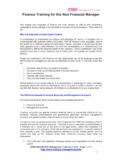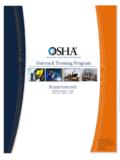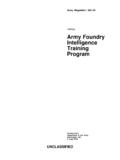Transcription of 5S Training - Lean Manufacturing Housekeeping
1 5S Training - lean Manufacturing Housekeeping 01565 653330 PHS Management Training 2004. Page 1 of 7 5S Training - The 5s Housekeeping Approach within lean Manufacturing What Is 5S? 5S is a set of techniques providing a standard approach to Housekeeping within lean Manufacturing . It is often promoted as being far more than simply Housekeeping and some of the elements described below certainly have broader implications. It originated, as did most of the elements of JIT, within Toyota. A cornerstone of 5S is that untidy, cluttered work areas are not productive. As well as the physical implications of junk getting in everybody's way and dirt compromising quality, we are all are happier in a clean and tidy environment and hence more inclined to work hard and with due care and attention.
2 Naturally enough, the elements of 5S are all Japanese words beginning with the letter S. Since their adoption within Western implementations of JIT, or lean Manufacturing , various anglicised versions of the terms have been adopted by different writers and educators. These are listed below against the individual elements and it can be seen that none are entirely satisfactory. lean Manufacturing Housekeeping 5S Training "pillars" The individual items within 5S are known as the "pillars" and are: 1. 5s Seiri (Sort) Seiri is the identification of the best physical Organisation of the workplace. It has been variously anglicised as Sort, Systematisation or Simplify by those wishing to retain the S as the initial letter of each element.
3 It is the series of steps by which we identify things which are being held in the workplace when they shouldn't, or are being held in the wrong place. 5S Training - lean Manufacturing Housekeeping 01565 653330 PHS Management Training 2004. Page 2 of 7 Put simply, we may identify a large area devoted to tools or gauges, some of which are needed regularly and some used infrequently. This brings all sorts of problems, including: Operators unable to find the item they need, being unable to see wood for trees. The time spent searching is a waste (or in Japanese speak a muda) and if we only held the items needed regularly in a prominent position we would save time.
4 Quality issues when gauges are not calibrated on time because too many are held. Safety issues when people fall over things. Lockers and racking cluttering the workplace making it hard to move around or to see each other and communicate. Some of the standard texts also talk about the elimination of excess materials and WIP. This is a complete restatement of all the JIT goals of releasing capital, reduced movement, shorter cycle times and so on. The question may be asked: should we then see inventory and WIP reduction as part of the implementation of the lean approach or as an element of 5S? The answer, as ever, is that keeping inventory and WIP to a minimum is simple best practice.
5 Whether we view it as JIT, or lean , or 5S or assign any other term is quite frankly irrelevant. The major element of Seiri is simply a critical look at the area. Involving cross-functional teams, or looking at each other's areas, is an obvious first step. People tend to be blind to failings in their own work place and a fresh pair of eyes can be useful. Another element of the standard approach is 'red tagging' where items are given a tag which says what the item is, which location it is in and when it was identified in this location. We then leave the area for a while and anybody using the item notes this. We go back some time later and can readily identify things that haven't moved, or been used.
6 Items which have not been used can then potentially be disposed of. As a first pass we should perhaps create a quarantine area before throwing items away, selling them or reworking them into something else. Other items may be deemed necessary but used infrequently and so an alternative location can be found. If the operator needs a particular tool only once or twice a month then a 20-yard walk is not a problem - especially if the space thus saved on the workbench helps to make the workplace more productive, or helps address quality issues. 5S Training - lean Manufacturing Housekeeping 01565 653330 PHS Management Training 2004.
7 Page 3 of 7 5s Housekeeping Training 2. 5s Seiton (Set) Seiton is the series of steps by which the optimum organisation identified in the first pillar are put into place. The standard translation is Orderliness but again some wish to keep the initial S and use Sort (yes, that is also one of the translations of Seiri), Set in order, Straighten and Standardisation. The sorting out process is essentially a continuation of that described in the Seiri phase. Removing items to be discarded or held in an alternative location will create space. This space will be visible and facilitate the alternative layout of the area.
8 In some cases, of course, we are talking about what a fitter will have on his bench, or in racks alongside the bench. In other cases we may be considering where we should locate a piece of plant - for example we may relocate a coin press to enable items to be completed in one work area rather than requiring a significant movement down the shop. This is something which we also undertake when adopting cellular Manufacturing . We then look at how we can restructure the work content so that certain operations can be carried out within the cycle of others - for example we may carry out a trimming operation on a steel component while the press which produced it is busy creating the next one.
9 Again, is this a 5S initiative, or part of a kaizen programme, or something else? Again, who cares, as long as we get on and achieve an improvement in business performance? Standardisation includes all the elements of setting out a consistent way of doing things. This includes standard Manufacturing methodologies, standard equipment and tooling, component rationalisation, drawing standardisation, consistency in the documentation which accompanies work, design for manufacture (or concurrent engineering) and standardisation in the clerical processes which deliver work to the shop floor and track its progress. All of this could be said to be part of a basic Total Quality approach.
10 The standard ways of doing things should include poka-yoke or error-proofing. Again it might be asked whether this is part of 5S or one aspect of a broader programme. 5S Training - lean Manufacturing Housekeeping 01565 653330 PHS Management Training 2004. Page 4 of 7 5s Training 3. 5s Seiso (Shine) Anglicised as Cleanliness but again the initial S can be retained in Shine, or Sweeping. The principle here is that we are all happier and hence more productive in clean, bright environments. There is a more practical element in that if everything is clean it is immediately ready for use. We would not want a precision product to be adjusted by a spanner that is covered in grease which may get into some pneumatic or hydraulic fittings.









